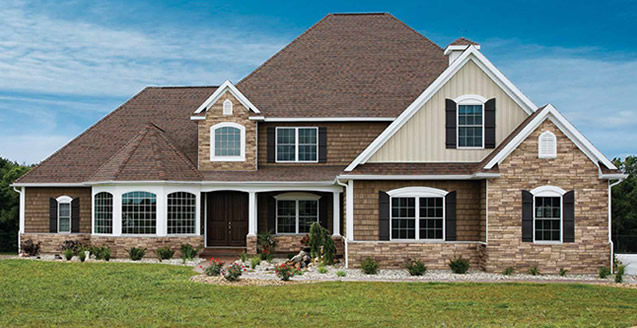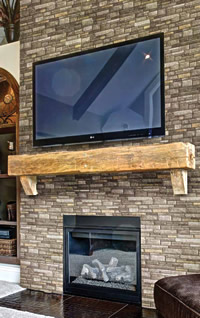
The home improvement trend
Any news of an improvement in the economy, or housing indicators that favour a sellers market, sends do-it-yourself consumers scurrying to the home improvement centres to get started on new projects. Leading research and advisory firm, TechNavio, has projected a compound annual growth rate of 3% from 2016 through 2020 in DIY home renovating and remodeling.1
Digital media has certainly helped encourage home improvement projects. How-to videos on YouTube and Vimeo, inspiration boards on Pinterest, websites like Houzz and Dwell, and TV shows like This Old House, Holmes on Homes, Fixer*Upper and Curb Appeal provide not only inspiration, but valuable knowledge. Manufacturers have embraced this new trend, and produce many options for installation by unskilled laborers. Many home improvement chains and megastores provide free weekend training events.
There are several primary reasons for homeowners to renovate their homes. Some may simply want to enhance their lifestyle. Or they have a long term plan to increase the value of their investment. Others may have decided to sell their home, in order to upgrade or downscale, and want to dramatically increase its perceived value, while investing no more than absolutely necessary. There has even been a renewed interest in flipping homes for profit over the past few years.
The most popular home renovations are those that are affordable, and dramatically enhance the look and feel of the home, but require very few tools homeowners don’t already have, or the development of any special skills. Popular projects are repainting and faux finishes, installing a new entrance or garage door, floating nailless hardwood flooring, groutless tile, modular kitchen cabinets with built-in leveling feet, and panelized manufactured stone. A whole new generation of products has been developed to meet the demand, replacing traditional installation methods.
Not everyone has the time or desire to become involved in a do-it-yourself project − even if it’s simple − but these homeowners still want to improve their homes. The DIY trend, with its low-cost, easy-to-install solutions, has delivered significant cost savings to owners who aren’t hands-on as well. Traditional building materials like stone, tile, cabinets and hardwoods were expensive, and required installation by skilled professionals. The new materials are very affordable, and with easy installation procedures geared towards homeowners, so it’s possible to hire handymen and general tradesmen to perform the installation.
For the biggest bang for the home renovation buck, it’s hard to beat the visual impact of stone. With panels, a bland home can be transformed over a weekend or two into a showstopper. In the interior, stone can become the focal point of a room, making it warm and inviting. The new panelized manufactured stone options are very affordable, easy to apply, and can be installed in applications where traditional stone was not an option. In the do-it-yourself marketplace, panelized stone veneers have become a runaway best seller.
Benefits of panelized manufactured stone
Fast installation
Traditional installation methods involved fastening each stone individually to the wall with mortar. A stone mason hand trimmed each stone, buttered it with mortar, and set it with care; and later the grout lines needed to be hand tooled. With stone panels, groups of stones are fastened in pre-assembled panels, with a hammer, drill or screw gun.
No mess
Panels are fastened mechanically, so mortar isn’t required to adhere stones to the wall, and they are tight fitting, so they don’t require any mortar between the stones. Without the mortar, there’s no mess to clean up later.
Can be installed year-round
Freezing temperatures, snow and rain can interfere with outdoor installation of traditional stone masonry. Even in indoor applications, due to the mess involved, mortar is typically still mixed outside. Because there’s no mortar involved, stone veneer panels can be installed any time of the year.
You can install it yourself
Panelized manufactured stone was designed so it can be installed with ease by do-it-yourself homeowners. Most products have excellent documentation available, as well as in depth video tutorials that cover all facets of the installation process.
Lower labour cost if you hire someone
If doing the installation yourself as a home project isn’t for you, it’s not necessary to hire a master stone mason, at top dollar. Most cities offer a selection of siding applicators, general contractors and handymen who are more than qualified to apply a cladding product designed for DIY installation.
Smaller footprint on a job site
On a typical job site, where conventional stone is being installed, you’re likely to find a pile of stone, mortar mixer, another pile of mortar sacks, perhaps a bench or table for the masonry saw, and a sizeable rubbish pile of stone cuttings and rejected stones. To aid in creating pleasing arrangements on the wall, stones will typically be spread out, so the mason can view the inventory he has to work with.
Stone veneer panels are thin, lightweight and the arrangement of stones has already been taken care of at the factory. A handyman’s circular saw or mitre/chop saw, with a masonry blade, is all that’s required to trim the ends of panels to length. With a panel system, cutting is minimized, and the thin veneer offcuts produce far less waste. There’s no mortar or mud outside, because the installation is dry.
Homebuilders love panelized stone veneers because one less contractor is needed on the job site. The siding contractor can also complete the stone installation.
Panelized manufactured stone can be installed in places traditional stone cannot
Traditional full-thickness stone masonry requires a wall that is strong enough to support the considerable weight of the stone and mortar, and a solid concrete footing. Manufactured stone veneer panels, on the other hand, are very lightweight, and require no mortar, so they can be installed almost anywhere. Suitable walls include wood frames, steel studs, pre-existing masonry, and pre-cast wall sections. Where a brick wall is structurally sound, and designed as a load bearing wall, panels can also be applied over existing brick.
Increased profits
Siding contractors can get a greater share of wallet by including the installation of panelized manufactured stone in their list of services. A portion of the money earmarked for a mason and stone yard can be diverted into the contractor’s existing cladding job. The benefits to the builder can be significant, so it can be a relatively easy upsell.
Versetta Stone®
 Boral’s Versetta Stone® is roughly one-fourth the weight of full-thickness stone. It’s made of lightweight aggregate materials, and the installation process does not require mortar. Versetta Stone® brings authenticity to their stone veneer, with colours, patterns and stone shapes that replicate natural stones. Stones are cast in molds and then hand-colored with iron oxide pigments.
Boral’s Versetta Stone® is roughly one-fourth the weight of full-thickness stone. It’s made of lightweight aggregate materials, and the installation process does not require mortar. Versetta Stone® brings authenticity to their stone veneer, with colours, patterns and stone shapes that replicate natural stones. Stones are cast in molds and then hand-colored with iron oxide pigments.
Flat Panels are the main component of the Versetta Stone® system. Each panel is 8″ x 36″ and weighs approximately 17 lbs (7.7kg). There is no fiddling with loose mounting clips, as is the case with some panelized solutions. Versetta panels are embedded with a G-90 galvanized nail strip, to facilitate easy installation. For moisture management, there is a 3/16” (4.76 mm) offset, and pre-drilled weep holes in the nail strips. Water is permitted to flow between the panels and the wall, draining out of the starter strips at the bottom. The air space and drainage help prevent mold growth.
The Universal Corner is a unique panel designed for inside and outside corners, and end wall terminations. It’s the perfect component for handling corners and transitions.
Versetta Stone® performs well under all conditions. It has been rigorously tested and meets all current standards for masonry veneer products. Nail strips have been designed to provide 60-year corrosion resistance. Exterior walls can handle 110 mph wind load resistance, have a Class A fire rating and have less than 3% mass loss during freeze/thaw cycles. Versetta Stone® is also NAHB Green Approved.
1. MarketResearch.com – Global DIY Market 2016-2020, TechNavio – Infiniti Research Ltd.